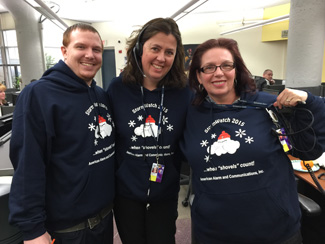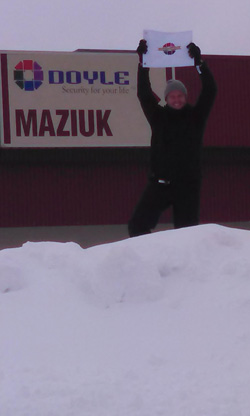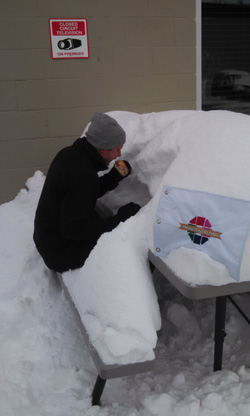Northeast's snow and central stations How do monitoring centers handle it?

By Spencer Ives
Updated Wed March 11, 2015
YARMOUTH, Maine—Amidst record-breaking amounts of snow, totaling more than 100 inches in some cities this winter, central stations in the Northeast still needed to operate fully staffed.
For American Alarm and Communications, based just outside Boston, which got walloped with 104 inches of snow by early March, that meant inflatable beds, hotel rooms and shovels. Amherst Alarm is based outside of Buffalo, N.Y., which experienced especially heavy snow in some parts and more normal accumulation in other. Things went smoothly for Doyle Security in Rochester, N.Y., but it still faced the challenge of continual snow clearing. Meanwhile, in Rockport, Maine, Seacoast Security said that its staff is used to heavy snowfall.

Photo: American Alarm and Communications operators, from left, James Bell, Mary Cokkinos, and Rosa Giulietti show off their new StormWatch 2015 sweatshirts with the new tagline "When "shovels" count..."
Preparations made in advance allowed central stations to overcome difficulties. One of the biggest concerns for a number of central stations was making sure that operators could get to work in treacherous conditions.
At American Alarm, “the biggest problem we faced was staffing, just getting people in,” Chris Newhook, American Alarm central station manager, told Security Systems News.
American's preparations panned out. “We did a lot to gear up for that,” Newhook said “We purchased a lot of inflatable beds and bedding for people who wanted to … sleep over here, we had hotels on hold for other operators as well.”
“They've left their families at home, they've put themselves in harm's way to make sure they're getting over here to support our customers. A pretty incredible bunch,” Newhook said.
The type of snow—light and fluffy because of the frigid temperatures—cut down on the problems expected, he said.

Photo: Doyle Security's Buffalo branch GM Jeremy Daumen climbs a mountain of snow at the office.
“You didn't have the weight … that would bring down tree branches that would, in turn, bring down wires,” he said. That resulted in fewer power outages than might usually be found in a nor'easter.
There was a surprising lack of alarm activity at some points, according to Newhook. Yet, at other points the low temperatures caused multiple pipe bursts.
During storms, American Alarm showed appreciation for its operators by keeping them comfortable in the central station. Shifts were kept more casual with a relaxed dress code, and some operators brought in personal affects—like their own alarm clocks and books—when sleeping over.
The company also had “Storm Watch 2015” commemorative sweatshirts made for the staff. “Then we did a play on words, because one of our mottos here is 'When seconds count.' We crossed that out and did 'When shovels count.' ”
Just outside of Buffalo, N.Y., it was the cold temperatures rather than the snow that affected Amherst Alarm and its clients,” said Tim Creenan, CEO of Amherst Alarm, a full-service alarm company.
“There was a much higher than normal amount of signals that came in for sprinkler water flow alarms. … It was the cold that broke the pipes,” Creenan said.
Creenan mentioned a very localized storm that happened in November. “During it there wasn't anything going on, there wasn't any snow here at our office—I mean, you could see the grass. Drive 10 minutes, [maybe] five minutes, to the other side of the airport—they were getting 4 and 5 feet of snow.” This sudden amount of snow, while not being as severe at Amherst's location, impeded the commute for some staff.
As such, like at American Alarm, the main problem at Amherst was staffing. “We had people who couldn't get in for three or four days… they literally couldn't get their cars down the streets,” Creenan said. “We would send somebody out with a four-wheel drive to pick them up and then drop people off as needed.”

Photo: Doyle GM Jeremy Daumen attempting to eat lunch.
Some operators volunteered to work extra shifts. “Everybody was really accommodating … so the customers really didn't feel any impacts or loss of service from us,” he said.
Cross-training of employees was another key. “A lot of people in our organization have come up through different departments, so they were able to pitch in and help out as needed,” Creenan said.
For Doyle Security in Rochester, N.Y, which is approaching 100 inches of snow for the season, a big problem was clearing the snow from the parking lot for each shift change, “But we worked closely with our snow removal contractors, and managed through that,” John Doyle, company CEO, told SSN. Also, travel times for service trucks were multiplied to two or three times their normal rate, Doyle said.
But because people pitched in and covered any gaps, “things went pretty smoothly for us all in all,” Doyle said.
It all comes with the territory, he said.
In Rockport, Maine, Paul Dunham, operations manager of Seacoast Security, said the snowfall was not outside what the company has seen before, and employees are used to it.
“We poll all of our dispatchers to see who's willing to come in if we need on-call help. We have people bring in what they're going to need in case they should have to stay a little later,” Dunham said.
Seacoast's employees are used to driving in snow and have the vehicles to handle it, he said.
Seacoast prepared for power outages when 2 feet of snow was headed to the area during one storm, but because it was a “light, powdery snow … the power stayed on, there were no issues, and it was a normal day,” he said.
Comments